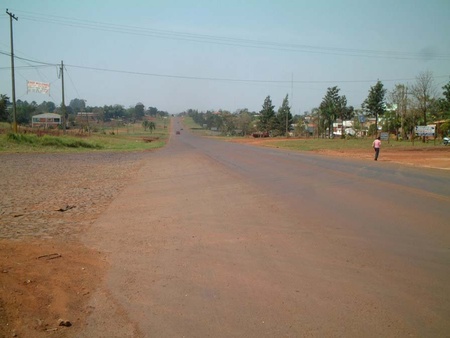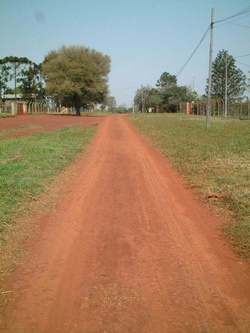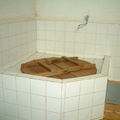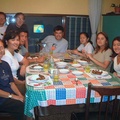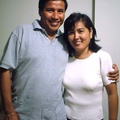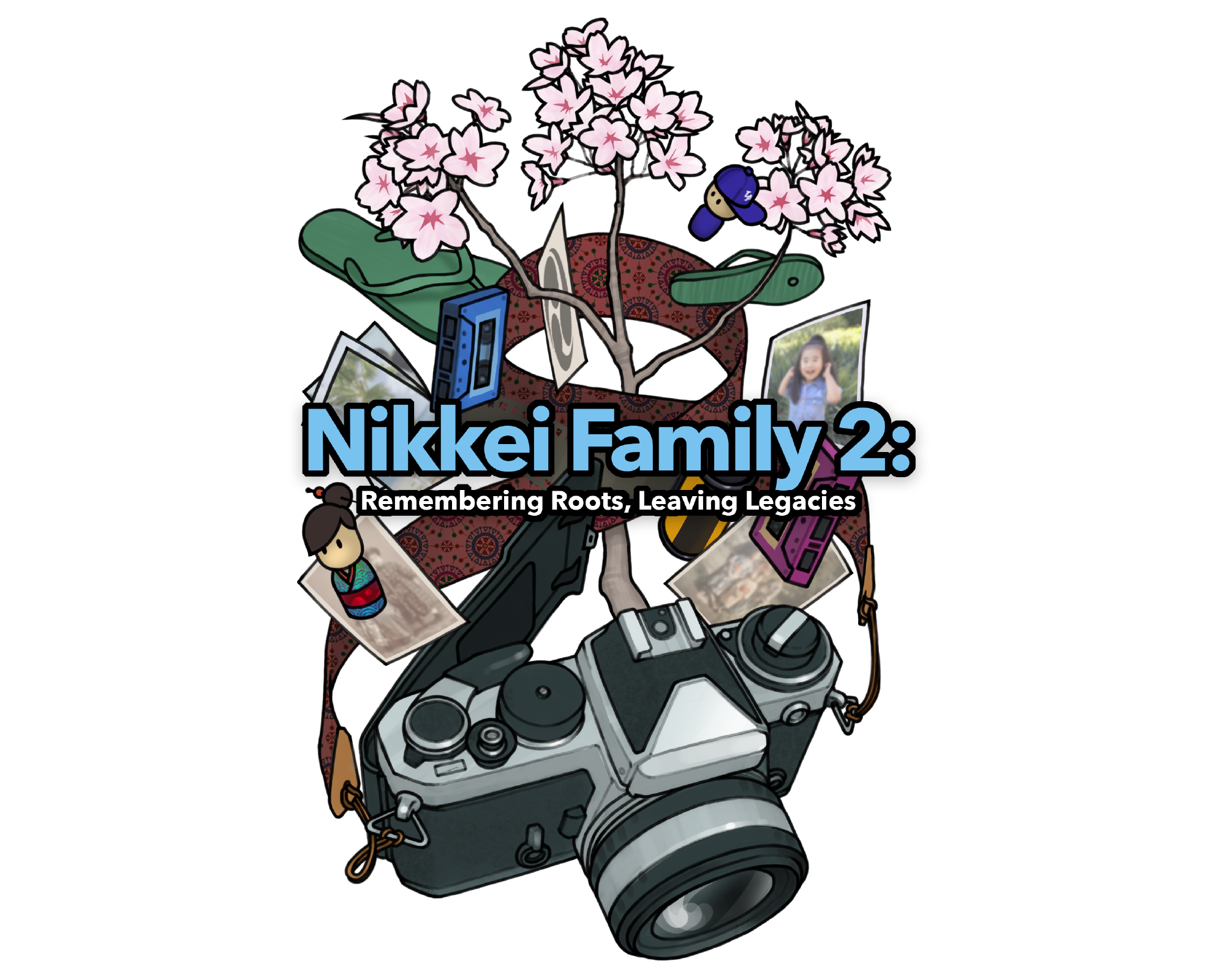Visit Iguazu
"Sir, we have arrived at the 42km point."
The conductor kindly came to inform me, so I grabbed my luggage and hurriedly got off the bus. We were in front of an ordinary village along a main road, with a gas station and a row of half-closed shops, standing silently in the darkness. The car whizzed by, completely ignoring the small village along the road.
I've arrived in a strange place. Will I be okay? I came here without much information about this place, and it was dark, so I was getting more and more anxious. Above all, there was not a single sign in Japanese around. It didn't seem like a place where anything could happen.
I was visiting Iguazu, one of the Japanese settlements.
There are many Japanese people living in Paraguay, and I have seen many of them in the cities I have visited. However, I had not been able to meet people who work in agriculture, which is the main occupation of immigrants, and I was also interested in the lives of people who gather in rural areas. I also wanted to visit the beautiful countryside of Paraguay. So when I found a description of the Iguazu settlement in an information notebook at my lodging in Encarnación, I came here relying only on that little bit of information.
According to the article, Iguazu is located about 40km from Ciudad del Este in Paraguay towards Asuncion, and is home to restaurants such as the Fukuoka Ryokan, Shirasawa Shokudo, and a central park with a torii gate.
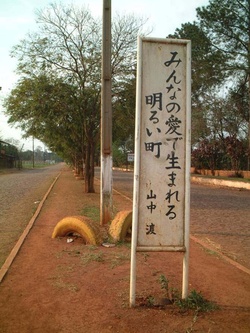
A sign with a slogan written in Japanese. However, this is the only Japanese sign I see while walking around. The names of Japanese stores are usually written in Roman letters.
"Um, where is Fukuoka Ryokan?"
Not knowing which way to go, I walked a little further to a shop and asked. The Paraguayan man then started talking to a Japanese-looking man in a group of people drinking beer nearby.
"Oh no, I can't speak Japanese."
I heard this Spanish, but immediately afterwards I heard surprisingly perfect Japanese.
"Um, do you want to go to Fukuoka Ryokan? It might be a bit far to walk from here with your luggage. Wait a bit, maybe someone will come to pick you up."
After saying this, the middle-aged man with a Japanese face took out his cell phone and made a call somewhere.
"Just wait a bit, they say they'll come to pick you up now."
After that, the man didn't speak to me again, but continued chatting in good spirits in fluent Spanish with the four or so Paraguayans who were drinking with him.
A car came to pick us up and we arrived safely at Fukuoka Ryokan, about 700 meters away. The woman at the inn also spoke Japanese normally and looked and was the same color as a typical Japanese woman.
"There are about 90 families of Japanese descent living around here. But there are also a lot of people who aren't of Japanese descent, like Brazilians and Germans."
"I'm sorry, it's so hot today that I didn't heat up the bath. I'm so sorry."
The manners are also very Japanese. The house is not particularly Japanese, but there is a picture of Kinkakuji on the wall of the room. NHK is on the TV and Japanese books are available to read. Breakfast is Japanese food and the bath is a Goemon bath. Since I was only planning to stay one night, it was a bit disappointing that I couldn't experience this Goemon bath.
However, the next morning I suddenly decided to stay another night, so I ended up taking a bath in the Goemon bath, taking a leisurely stroll around the village, and finishing off reading Yukio Mishima's "The Temple of the Golden Pavilion" while admiring a painting of the temple.
The reason I decided to stay an extra night was because there were Japanese-language documents about the Yguazu settlement at the inn (most Japanese immigrant homes have such books). Paraguay is a minor country in South America. When did the Japanese come here, and what kind of life are they living now? I felt a strong desire to write an article based on the documents and my own experiences.
It's already 3am. I don't want to drag this out any longer, so I'll try my best to write.
When and why did the Japanese come?
At first, I was surprised by the fact that Japanese people in Paraguay can understand Japanese. The Japanese people I met in Peru were either better at Spanish or only spoke Spanish. This is because the history of immigration to Paraguay is not as old as that of Peru, and settlement in areas other than La Colmena all began after the war. I imagine that the language and culture may have been more easily preserved if they were in the slow-paced environment of Paraguay's rural areas, compared to the Japanese Peruvians who gave up farming and concentrated in cities.
Brazil was once the largest recipient of Japanese immigrants. However, anti-Japanese sentiment grew, and the "Foreign Immigrants Restriction Law" was finally enacted, dramatically reducing the number of Japanese people who could immigrate to Brazil. So Paraguay emerged as a new recipient.
Paraguay's population plummeted after being exhausted by wars with neighboring countries, dropping from 600,000 to 850,000 people to just 260,000 by 1886. Paraguay may look small on a map of South America, but its land area is slightly larger than Japan's. With such a small population, the economic and social situation was serious. So first immigrants from European countries were accepted, and then from 1936 until World War II, over 700 Japanese people immigrated to the country.
After the Second World War, the acceptance of Japanese immigrants was suspended but was resumed, and agricultural migration to Paraguay flourished from the 1950s to the early 1960s. Migration to Yguazu also began in 1961, but as Japan entered a period of rapid economic growth, the motivation to migrate weakened and the number of settlers decreased. Currently, the Japanese population in Paraguay is said to be 7,000, which is considerably smaller than other South American migration destinations.
Life after migration and crops
Immediately after settling in Iguazu, the immigrants lived in shabby temporary huts and devoted themselves to development. At the time, the area was covered in dense virgin forests and inhabited by wild animals such as leopards. Transportation was still inconvenient, making it impossible to sell crops, and the people lived mostly self-sufficiently. In the 1960s, no particular crops were established, and attempts were made to introduce soybeans, rice, and wheat, but without success. Many people began planting tung trees, whose prices had skyrocketed, but they were wiped out by leaf-cutter ants. Eventually, they began to transport tomatoes and chicken eggs by regular bus service to Asuncion to sell at the market.
In the 1970s, immigrants continued to find themselves in a tough economic situation, and vegetable crops, which have a fast turnover rate, became the main crop. Cultivation of tomatoes and melons in particular spread, and efforts to raise chickens and beef cattle also became more widespread. In 1972, large farm machinery such as bulldozers and tractors were introduced, and land reclamation progressed, resulting in a rapid increase in the amount of cultivated land. The number of farmers growing soybeans also increased.
In the 1980s, sericulture came to a halt, and vegetable cultivation also became unsustainable. Many farmers sold their land and returned to their home countries, and more people went to Japan to earn money. However, after no-till farming techniques began to spread from 1983, the Japanese-Brazilian economy recovered rapidly, supported by soaring soybean prices.
No-till cultivation is the practice of planting the next crop without plowing the land after harvesting the previous year's crop. It took some time to reach the practical stage because it requires a special seeding machine and herbicides. However, once it was established as a measure against soil erosion caused by rainwater, it eliminated the need for plowing and leveling the land, greatly reduced labor, and increased yields because seeds could be sown on time.
* This travelogue was written in September 2004, and the information contained herein is accurate as of that time. It is reprinted from " Sawako's Wondering the World, " which records her solo travels around the world over a period of more than three years.
© 2004 Sawako Suganuma


